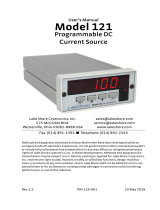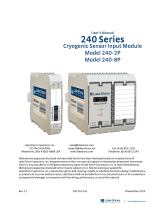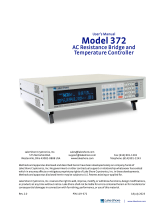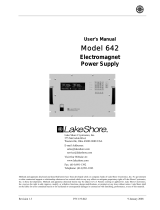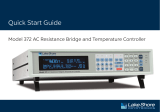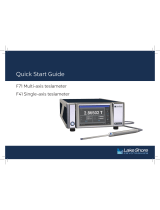Page is loading ...

Rev. 1.8 P/N 119-021 03 October 2013
User’s Manual
Model 231 / 231P
Temperature Transmitter
Includes Coverage for:
Model 2308-01 Benchtop Enclosure
Model 2308-12 VMEbus Rackmount Case
For Use With The Following Lake Shore Sensors:
Model DT-414 Unencapsulated Silicon Diode Temperature Sensors
Series DT-420 Miniature Silicon Diode Temperature Sensors
Series DT-470 Silicon Diode Temperature Sensors
Series DT-471 Silicon Diode Temperature Sensors
Series DT-670 Silicon Diode Temperature Sensors
Series PT-100 Platinum Resistance Thermometers
Series TG-120 GaAlAs Diode Temperature Sensors
Lake Shore Cryotronics, Inc.
575 McCorkle Boulevard
Westerville, Ohio 43082-8888 USA
E-Mail Addresses:
Visit Our Website:
www.lakeshore.com
Fax: (614) 891-1392
Telephone: (614) 891-2243
Methods and apparatus disclosed and described herein have been developed solely on company funds of Lake
Shore Cryotronics, Inc. No government or other contractual support or relationship whatsoever has existed which in
any way affects or mitigates proprietary rights of Lake Shore Cryotronics, Inc. in these developments. Methods and
apparatus disclosed herein may be subject to U.S. Patents existing or applied for. Lake Shore Cryotronics, Inc.
reserves the right to add, improve, modify, or withdraw functions, design modifications, or products at any time
without notice. Lake Shore shall not be liable for errors contained herein or for incidental or consequential damages
in connection with furnishing, performance, or use of this material.

Lake Shore Model 231 User’s Manual
LIMITED WARRANTY STATEMENT – WARRANTY PERIOD: THREE (3) YEAR
1. Lake Shore warrants that products manufactured by Lake Shore (the "Product") will be free from
defects in materials and workmanship for three years from the date of Purchaser's physical
receipt of the Product (the "Warranty Period"). If Lake Shore receives notice of any such defects
during the Warranty Period and the defective Product is shipped freight prepaid back to Lake
Shore, Lake Shore will, at its option, either repair or replace the Product (if it is so defective)
without charge for parts, service labor or associated customary return shipping cost to the
Purchaser. Replacement for the Product may be by either new or equivalent in performance to
new. Replacement or repaired parts, or a replaced Product, will be warranted for only the
unexpired portion of the original warranty or 90 days (whichever is greater).
2. Lake Shore warrants the Product only if the Product has been sold by an authorized Lake Shore
employee, sales representative, dealer or an authorized Lake Shore original equipment
manufacturer (OEM).
3. The Product may contain remanufactured parts equivalent to new in performance or may have
been subject to incidental use when it is originally sold to the Purchaser.
4. The Warranty Period begins on the date of Purchaser's physical receipt of the Product or later
on the date of operational training and verification (OT&V) of the Product if the service is
performed by Lake Shore, provided that if the Purchaser schedules or delays the Lake Shore
OT&V for more than 30 days after delivery then the Warranty Period begins on the 31st day
after Purchaser's physical receipt of the Product.
5. This limited warranty does not apply to defects in the Product resulting from (a) improper or
inadequate installation (unless OT&V services are performed by Lake Shore), maintenance,
repair or calibration, (b) fuses, software, power surges, lightning and non-rechargeable
batteries, (c) software, interfacing, parts or other supplies not furnished by Lake Shore, (d)
unauthorized modification or misuse, (e) operation outside of the published specifications, (f)
improper site preparation or site maintenance (g) natural disasters such as flood, fire, wind, or
earthquake, or (h) damage during shipment other than original shipment to you if shipped
through a Lake Shore carrier.
6. This limited warranty does not cover: (a) regularly scheduled or ordinary and expected
recalibrations of the Product; (b) accessories to the Product (such as probe tips and cables,
holders, wire, grease, varnish, feed throughs, etc.); (c) consumables used in conjunction with
the Product (such as probe tips and cables, probe holders, sample tails, rods and holders,
ceramic putty for mounting samples, Hall sample cards, Hall sample enclosures, etc.); or, (d)
non-Lake Shore branded Products that are integrated with the Product.
7. To the extent allowed by applicable law,, this limited warranty is the only warranty applicable to
the Product and replaces all other warranties or conditions, express or implied, including, but
not limited to, the implied warranties or conditions of merchantability and fitness for a particular
purpose. Specifically, except as provided herein, Lake Shore undertakes no responsibility that
the products will be fit for any particular purpose for which you may be buying the Products. Any
implied warranty is limited in duration to the warranty period. No oral or written information, or
advice given by the Company, its Agents or Employees, shall create a warranty or in any way
increase the scope of this limited warranty. Some countries, states or provinces do not allow
limitations on an implied warranty, so the above limitation or exclusion might not apply to you.
This warranty gives you specific legal rights and you might also have other rights that vary from
country to country, state to state or province to province.
8. Further, with regard to the United Nations Convention for International Sale of Goods (CISC,) if
CISG is found to apply in relation to this agreement, which is specifically disclaimed by Lake
Shore, then this limited warranty excludes warranties that: (a) the Product is fit for the purpose
for which goods of the same description would ordinarily be used, (b) the Product is fit for any
particular purpose expressly or impliedly made known to Lake Shore at the time of the
conclusion of the contract. (c) the Product is contained or packaged in a manner usual for such
goods or in a manner adequate to preserve and protect such goods where it is shipped by
someone other than a carrier hired by Lake Shore.
9. Lake Shore disclaims any warranties of technological value or of non-infringement with respect
to the Product and Lake Shore shall have no duty to defend, indemnify, or hold harmless you
from and against any or all damages or costs incurred by you arising from the infringement of
patents or trademarks or violation or copyrights by the Product.
10. THIS WARRANTY IS NOT TRANSFERRABLE. This warranty is not transferrable.
11. Except to the extent prohibited by applicable law, neither Lake Shore nor any of its
subsidiaries, affiliates or suppliers will be held liable for direct, special, incidental, consequential

Rev. 1.8 P/N 119-021 03 October 2013
or other damages (including lost profit, lost data, or downtime costs) arising out of the use,
inability to use or result of use of the product, whether based in warranty, contract, tort or other
legal theory, regardless whether or not Lake Shore has been advised of the possibility of such
damages. Purchaser's use of the Product is entirely at Purchaser's risk. Some countries, states
and provinces do not allow the exclusion of liability for incidental or consequential damages, so
the above limitation may not apply to you.
12. This limited warranty gives you specific legal rights, and you may also have other rights that
vary within or between jurisdictions where the product is purchased and/or used. Some
jurisdictions do not allow limitation in certain warranties, and so the above limitations or
exclusions of some warranties stated above may not apply to you.
Except to the extent allowed by applicable law, the terms of this limited warranty statement do not
exclude, restrict or modify the mandatory statutory rights applicable to the sale of the product to
you. CERTIFICATION
Lake Shore certifies that this product has been inspected and tested in accordance with its
published specifications and that this product met its published specifications at the time of
shipment. The accuracy and calibration of this product at the time of shipment are traceable to the
United States National Institute of Standards and Technology (NIST); formerly known as the
National Bureau of Standards (NBS), or to a recognized natural standard.
TRADEMARK ACKNOWLEDGEMENT
Manufacturers and sellers claim many designations as trademarks to distinguish their products.
Where those designations appear in this manual and Lake Shore was aware of a trademark claim,
the designations appear in initial capital letters with a ™ or ® symbol.
Apiezon® is a trademark of Biddle Instruments.
CalCurve™, Carbon-Glass™, Cernox™, Duo-Twist™, High-Temperature Cernox™, Quad-
Lead™, Quad-Twist™, Rox™, SoftCal™, and Thermox™ are trademarks of Lake Shore
Cryotronics, Inc.
Teflon® is a trademark of DuPont De Nemours.
Copyright © 1993, 1998-99, 2001, 2004, 2012-13 by Lake Shore Cryotronics, Inc. All rights
reserved. No portion of this manual may be reproduced, stored in a retrieval system, or
transmitted, in any form or by any means, electronic, mechanical, photocopying, recording, or
otherwise, without express written permission of Lake Shore.


Lake Shore Model 231 User’s Manual


Lake Shore Model 231 User’s Manual
Table of Contents
i
TABLE OF CONTENTS
Chapter/Paragraph Title Page
1 INTRODUCTION .......................................................................... 1-1
1.0 General .......................................................................... 1-1
1.1 Model 231 System Description ...................................... 1-1
1.2 Single Enclosure Case Description ................................ 1-6
1.3 Multiple Unit Enclosure Case Description ...................... 1-7
2 INSTALLATION ........................................................................... 2-1
2.0 General .......................................................................... 2-1
2.1 Inspection and Unpacking .............................................. 2-1
2.2 Repackaging For Shipment ........................................... 2-1
2.3 Sensor Installation Recommendations........................... 2-2
2.3.1 Two-Lead vs. Four-Lead Measurements .................... 2-2
2.3.1.1 Two-Lead Measurements ....................................... 2-2
2.3.1.2 Four-Lead Measurements ...................................... 2-3
2.3.2 Connecting Leads To The Sensor .............................. 2-3
2.3.3 Sensor Mounting ........................................................ 2-3
2.3.4 Measurement Errors Due To AC Noise ...................... 2-4
2.4 Sensor Curve Definition ................................................. 2-5
2.5 Power Connections ........................................................ 2-6
3 OPERATION ................................................................................ 3-1
3.0 General .......................................................................... 3-1
3.1 PCB DIP Switch Settings ............................................... 3-1
3.2 Output to Temperature Conversion ............................... 3-2
4 SERVICE ..................................................................................... 4-1
4.0 General .......................................................................... 4-1
4.1 General Troubleshooting ............................................... 4-1
4.1.1 No Output (On-Board LED Off) .................................. 4-1
4.1.2 Output Stops Before Reaching Upper Limit ............... 4-1
4.1.3 Output Is Incorrect Value (Small Error) ...................... 4-1
4.1.4 Output Is Incorrect Value (Large Error) ...................... 4-2
4.2 Model 231 Connector Definitions ................................... 4-2
4.3 Calibration ...................................................................... 4-3
4.3.1 Test Equipment Required ........................................... 4-3
4.3.2 Reference Calibration ................................................. 4-4
4.3.3 Output Calibration ...................................................... 4-5

Lake Shore Model 231 User’s Manual
ii
Table of Contents
TABLE OF CONTENTS (Continued)
Chapter/Paragraph Title Page
5 OPTIONS AND ACCESSORIES ................................................. 5-1
5.0 General .......................................................................... 5-1
5.1 Enclosures ..................................................................... 5-1
5.2 Options........................................................................... 5-1
5.3 Accessories .................................................................... 5-2
5.4 Wires .............................................................................. 5-2
5.5 Sensors .......................................................................... 5-3
5.6 Special Equipment ......................................................... 5-3
APPENDIX A – MODEL 231 CURVE TABLES ................................. A-1
APPENDIX B – GLOSSARY OF TERMINOLOGY ............................ B-1
LIST OF ILLUSTRATIONS
Figure No. Title Page
1-1 Typical Model 231 Front Panel.............................................. 1-2
1-2 Single Enclosure Case Physical Dimensions ........................ 1-6
1-3 Multiple Unit Case Physical Dimensions ............................... 1-8
2-1 Typical Wall Plug-In Power Supply ....................................... 2-7
3-1 Model 231 DIP Switch (S1) ................................................... 3-1
4-1 Front Panel Connectors J2 & J3 Details ............................... 4-2
4-2 VMEbus Connector J1 Details .............................................. 4-3
4-3 Model 231 PCB Layout ......................................................... 4-4
LIST OF TABLES
Table No. Title Page
1-1 Model 231 Input Specifications ............................................. 1-3
1-2 Model 231P Input Specifications ........................................... 1-4
1-3 Model 231 & 231P Output Specifications .............................. 1-5
1-4 Model 2308-12 VMEbus Rackmount Case Specs ................ 1-7
2-1 Effect of Current Variation on Diode Temperature ................ 2-5
2-2 Typical DT-470 dV/dI Values for Selected Temps ................. 2-5
3-1 Conversion Parameters for Temperature in K ....................... 3-2
A-1 Lake Shore Standard Diode Curves ......................................A-1
A-2 Series PT-100 Platinum Resistance Curve ...........................A-2

Lake Shore Model 231 User’s Manual
Introduction 1-
1
CHAPTER 1
INTRODUCTION
1.0 GENERAL
Lake Shore Cryotronics designed and manufactures the Model 231 in the
United States of America. In general, reference to the Model 231 means
both the Model 231 and 231P. Specific references are made where
appropriate. This chapter provides a general description with specifications
in Paragraph 1.1, single-enclosure case description in Paragraph 1.2, and
multiple-unit enclosure case description in Paragraph 1.3.
We welcome comments on this manual. Although we try to keep it error-free,
some may occur. To report an error, describe it briefly and include the
appropriate paragraph, figure, table, and page number. Send comments to
Lake Shore Cryotronics, Attn: Technical Publications, 575 McCorkle Blvd.,
Westerville, Ohio 43082-8888. This manual is subject to change without
notice.
1.1 MODEL 231 GENERAL DESCRIPTION
The Model 231 Temperature Transmitter is available as a stand-alone unit or
for use within either of two enclosures: a Model 2308-1 single-space
enclosure, or a Model 2308-12 rackmount case that holds up to 12 units.
The Model 231 Temperature Transmitter sends temperature data from its
position near a sensor to a data acquisition channel or strip chart recorder. It
operates with Silicon diode or Gallium-Aluminum-Arsenide (GaAlAs) diode
sensors. Lake Shore Silicon diode sensors are accurate over a wide
cryogenic temperature range and are interchangeable for some applications.
The Lake Shore Series TG-120 GaAlAs diodes operate in a low to moderate
magnetic field. Excited with a 10 µA current source from the Model 231, the
sensors produce a voltage that depends on temperature. A microcontroller
reads the voltage through an A/D converter and translates it into
temperature. Either the standard temperature curve or an optional
CalCurve™ relates voltage to temperature (the Series TG-120 requires a
CalCurve).
The Model 231P uses a Series PT-100 Platinum Thermometer. The Model
231P excites the sensor with a 500 µA current to produce a measurable
signal. Either the standard platinum curve (DIN 437600) or a CalCurve is
used for temperature conversion.

Lake Shore Model 231 User’s Manual
1-
2
Introduction
Once the Model 231 obtains temperature data, it
transmits it as a current from 4 to 20 mA. The
current output changes linearly with sensor
temperature. Output scale depends on the selected
temperature range. Several switch selected ranges
are available. For highest accuracy and sensitivity,
set the output for a narrow temperature band. An
optional 0 to 20 mA output is also available to
convert output to a voltage reading scaled from zero.
A 500 ±0.02% precision resistor is provided for
this purpose. This resistor produces the maximum
full-scale output of 10 V.
A single +5 VDC supply powers Model 231 circuitry.
The outputs are isolated so several 231s can
operate from the same supply without interference.
The +5 VDC can also be supplied from the pins on
the VME bus connector.
Mechanical mounting is easy because the
Model 231 is built on a standard size VME card.
It fits directly into a single height (3U) VME card
holder. The transmitter does not use the electrical
bus format, only its physical shape and power
supply.
Figure 1-1. Typical
Model 231 Front Panel

Lake Shore Model 231 User’s Manual
Introduction 1-
3
Table 1-1. Model 231 Input Specifications
Thermometry:
Number of Inputs: One input
Measurement Type: Four-lead differential
Sensor Type: Silicon diode, GaAlAs diode (to 5V)
Sensor Temp. Coefficient: Negative
Sensor Units: Volt (V)
Input Range: 0 – 5 volts
Sensor Excitation: 10 µA ±0.1% DC current
Update Rate: 5 readings per second
CalCurve Storage: 1 curve, loaded in PROM at factory
Example Lake Shore Sensor: DT-470-CO
Temperature Range: 1.4 K – 325 K with DT-470
Standard Curve: Curve 10
Typical Sensor Sensitivity: –30 mV/K at 4.2 K
–1.9 mV/K at 77.35 K
–2.4 mV/K at 300 K
Measurement Resolution:
Sensor Units: 76.3 µV
Temp. Equivalence: 2.5 mK at 4.2 K
40 mK at 77.35 K
32 mK at 300 K
Measurement Accuracy:
Sensor Units: ±75 µV ±0.01% of reading
Temp. Accuracy *: ±0.07 K at 4.2 K
±0.16 K at 77.35 K
±0.12 K at 300 K
* DT-470-CO with 8001 CalCurve.
Measurement Temperature Coefficient:
Sensor Units: 0.0006% of voltage reading per °C
Temp. Equivalence: 3 mK/°C at 4.2 K
3 mK/°C at 77.35 K
1.2 mK/°C at 300 K
Typical Performance With Series TG-120 Sensor:
Similar to selected example diode sensor with improved
measurement resolution and temperature resolution at
temperatures of 4 K to 50 K. Sensor voltage must not
exceed 5 V at lowest operating temperature.

Lake Shore Model 231 User’s Manual
1-
4
Introduction
Table 1-2. Model 231P Input Specifications
Thermometry:
Number of Inputs: One input
Measurement Type: Four-lead differential
Sensor Type: Platinum
Sensor Temp. Coefficient: Positive
Sensor Units: Ohm ()
Input Range: 0 – 312
Sensor Excitation: 500 µA ±0.02% DC current
Update Rate: 5 readings per second.
CalCurve Storage: 1 curve, loaded in PROM at factory.
Example Lake Shore Sensor: PT-103
Temperature Range: 14 K – 873 K with PT-103
Standard Curve: DIN 43760
Typical Sensor Sensitivity: 0.19 /K @ 30 K
0.42 /K @ 77.35 K
0.39 /K @ 300 K
0.34 /K typical up to 800 K
Measurement Resolution:
Sensor Units: 4.8 m
Temp. Equivalence: 22 mK at 30 K
11 mK at 77.35 K
13 mK at 300 K
14 mK typical up to 800 K
Measurement Accuracy:
Sensor Units: Ohms ()
Temp. Accuracy: ±0.2 K at 30 K
±0.15 K at 77.35 K
±0.3 K at 300 K
±0.7 K typical up to 800 K
Measurement Temperature Coefficient:
Sensor Units: 0.002% of voltage reading per °C
Temp. Equivalence: 0.4 mK/°C at 30 K
1 mK/°C at 77.35 K
6 mK/°C at 300 K
18 mK/°C at 800 K
Magnetic Field Use: Up to 19 teslas for T > 30 K.

Lake Shore Model 231 User’s Manual
Introduction 1-
5
Table 1-3. Model 231 and 231P Output Specifications
Output:
Number of Outputs: One
Output Type: Current source, isolated from power source but not
sensor input
Output Range: 4 – 20 mA or 0 – 20 mA (for 0 – 10 V with provided
500 , 0.02%, 25 ppm resistor)
Output Compliance: 10 V (500 max load)
Output Temperature Ranges: 0 – 20 K, 0 – 100 K, 0 – 200 K,
0 – 325 K, 0 – 475 K, and 0 – 1000 K
4 – 20 mA Output:
Output Resolution:
Current: ±1.22 µA ±0.006% of full scale
Temp. Equivalence: 0–20 K = 1.5 mK 0–325 K = 24.8 mK
0–100 K = 7.6 mK 0–475 K = 36.2 mK
0–200 K = 15.3 mK 0–1000 K = 76.3 mK
Output Accuracy:
Current: ±2 µA ±0.01% of full scale
Temp. Equivalence: 0–20 K = 2.5 mK 0–325 K = 41 mK
0–100 K = 12.5 mK 0–475 K = 59 mK
0–200 K = 25 mK 0–1000 K = 125 mK
Output Temperature Coefficient:
Current (% output/°C ambient): ±0.0055%/°C
Temp. Equivalence: 0–20 K = 1 mK/°C 0–325 K = 18 mK/°C
0–100 K = 6 mK/°C 0–475 K = 26 mK/°C
0–200 K = 12 mK/°C 0–1000 K = 55 mK/°C
0 – 20 mA Output (0-10 V w/500 , 0.02% Load Resistor):
Output Resolution:
Voltage: 0.6 mV ±0.006% of full scale
Temp. Equivalence: 0–20 K = 1.2 mK 0–325 K = 19.8 mK
0–100 K = 6.1 mK 0–475 K = 29 mK
0–200 K = 12.2 mK 0–1000 K = 61 mK
Output Accuracy:
Voltage: ±3 mV ±0.03% of full scale
Temp. Equivalence: 0–20 K = 6 mK 0–325 K = 98 mK
0–100 K = 30 mK 0–475 K = 143 mK
0–200 K = 60 mK 0–1000 K = 300 mK
Output Temperature Coefficient:
Voltage (% Output/°C ambient): ±0.008%/°C
Temp. Equivalence: 0–20 K = 2 mK/°C 0–325 K = 26 mK/°C
0–100 K = 8 mK/°C 0–475 K = 38 mK/°C
0–200 K = 16 mK/°C 0–1000 K = 80 mK/°C

Lake Shore Model 231 User’s Manual
1-
6
Introduction
Table 1-3 Model 231 & 231P Output Specifications (Continued)
General:
Ambient Temperature Range: 15 – 35 °C
Power Requirement: +5 (±0.25) VDC, 500 mA
Size: 100 mm high × 160 mm deep × 30.5 mm wide
Mounting: VME end panel and back plane. Transmitter does
not use electrical bus format, only its physical shape and
power supply.
Note: Electronic temperature accuracy in a given temperature
range is the sum of temperature accuracies of input and output.
Sensor calibration errors are not included.
1.2 SINGLE ENCLOSURE CASE DESCRIPTION
Holds one Model 231. Typical dimensions appear below.
Figure 1-2. Typical Single Enclosure Case Physical Dimensions

Lake Shore Model 231 User’s Manual
Introduction 1-
7
1.3 MULTIPLE UNIT ENCLOSURE CASE DESCRIPTION
The Model 2308-12 VMEbus Rackmount Case holds up to 12 Model 231
units. A +5 VDC power supply with universal input is provided with the case.
Specifications and typical dimensions of the case are shown below. Refer to
Paragraph 2.5 for further information on the built-in power supply.
CAUTION: The Model 2308-12 bus is designed only to power multiple
Model 231s. Do not use with standard VME cards.
Table 1-4. Model 2308-12 VMEbus Rackmount Case Specifications
No. of Card Slots: 12
Size: 45 × 17.8 × 26 centimeters (17.7 × 7 × 10.25 inches)
Weight: 5.5 kilograms (12 pounds)
Output Voltage: +5 VDC, 100 mV Peak-to-Peak Ripple
Output Current: 6 Amperes (Maximum)
Input Power: Universal 85 – 265 VAC, 47 – 440 Hz., 60 Watts
Ambient Temp. Range: 15 – 35 °C (59 – 95 °F)

Lake Shore Model 231 User’s Manual
1-
8
Introduction
Figure 1-3. Typical Multiple Unit Case Physical Dimensions

Lake Shore Model 231 User’s Manual
Installation 2-
1
CHAPTER 2
INSTALLATION
2.0 GENERAL
This chapter covers inspection and unpacking in Paragraph 2.1, repackaging
for shipment in Paragraph 2.2, sensor installation recommendations in
Paragraph 2.3, sensor curve definitions in Paragraph 2.4, and power
connections in Paragraph 2.5.
2.1 INSPECTION AND UNPACKING
Inspect shipping containers for external damage. Make all claims for
damage (apparent or concealed) or partial loss of shipment in writing to
Lake Shore within 5 days from receipt of goods. If damage or loss is
apparent, please notify the shipping agent immediately.
Open the shipping containers. Use the packing list included with the system
to verify receipt of the instrument, sensor, accessories, and manual. Inspect
for damage. Inventory all components supplied before discarding any
shipping materials. If there is freight damage to the instrument, file proper
claims promptly with the carrier and insurance company and notify Lake
Shore. Notify Lake Shore immediately of any missing parts. Lake Shore
cannot be responsible for any missing parts unless notified within 60 days
of shipment. Refer to the standard Lake Shore Warranty on the A Page
(immediately behind the title page).
2.2 REPACKAGING FOR SHIPMENT
To return the Model 231 or accessories for repair or replacement, obtain a
Return Goods Authorization (RGA) number from Technical Service in the
United States, or from the authorized sales/service representative from
which the product was purchased. Instruments may not be accepted without
a RGA number. When returning an instrument for service, Lake Shore must
have the following information before attempting any repair.
1. Instrument model and serial number.
2. User name, company, address, and phone number.
3. Malfunction symptoms.
4. Description of system.
5. Returned Goods Authorization (RGA) number.
Repack the system in its original container (if available). Affix shipping labels
and FRAGILE warnings. Write RGA number on the outside of the container
or on the packing slip. If not available, consult Lake Shore for shipping and
packing instructions.

Lake Shore Model 231 User’s Manual
2-
2
Installation
2.3 SENSOR INSTALLATION RECOMMENDATIONS
Refer to the Lake Shore Product Catalog for installation details and sensor
specifications. Call Lake Shore for copies of application notes or sensor
installation questions. Below are general recommendations on sensor
installation:
1. Do not ground the sensor.
2. Shield leads and connect shield wire to SHIELD on screw terminal
connector only. Do not connect shield at other end of cable.
3. Keep leads as short as possible.
4. Use twisted-pair wire. Use Lake Shore Duo-Twist™ wire (or equivalent)
for two-wire, or Quad-Twist™ wire (or equivalent) for four-wire
applications.
5. Thermally anchor lead wires.
2.3.1 Two-Lead versus Four-Lead Measurements
In two-lead measurement, the leads that measure sensor voltage also carry
the current. The voltage measured at the instrument is the sum of the
temperature sensor voltage and the IR voltage drop within the two current
leads. Since heat flow down the leads can be critical in a cryogenic
environment, wire of small diameter and significant resistance per foot is
preferred to minimize this heat flow. Consequently, a voltage drop within the
leads may exist.
Four-lead measurement confines current to one pair of leads and measures
sensor voltage with the other lead pair carrying no current.
2.3.1.1 Two-Lead Measurement
Sometimes system constraints dictate
two-lead measurement. Connect the
positive terminals (V+ and I+) together
and the negative terminals (V– and I–)
together at the instrument, then run
two leads to the sensor.
Expect some loss in accuracy; the voltage measured at the voltmeter equals
the sum of the sensor voltage and the voltage drop across the connecting
leads. The exact measurement error depends on sensor sensitivity and
variations resulting from changing temperature. For example, a 10 lead
resistance results in a 0.1 mV voltage error. The resultant temperature error
at liquid helium temperature is only 3 mK, but, because of the lower
sensitivity (dV/dT) of the diode at higher temperatures, it becomes 10 mK at
liquid nitrogen temperature.
I+
V+
I–
V–
Two-Lead
Measurements

Lake Shore Model 231 User’s Manual
Installation 2-
3
2.3.1.2 Four-Lead Measurement
All sensors, both two-lead and four-lead
devices, can be measured in a four-lead
configuration to eliminate the effects of lead
resistance. The exact point at which the
connecting leads solder to the two-lead
sensor normally results in a negligible
temperature uncertainty.
Always use four-lead measurement configuration
when a Series PT-100 Platinum Sensor is attached to the Model 231P.
2.3.2 Connecting Leads To The Sensor
Excessive heat flow through connecting leads to any temperature sensor
may differ the temperature between the active sensing element and the
sample to which the sensor mounts. This reflects as a real temperature
offset between what is measured and the true sample temperature.
Eliminate such temperature errors with proper selection and installation of
connecting leads.
To minimize heat flow through the leads, select leads of small diameter and
low thermal conductivity. Phosphor-bronze or Manganin wire is commonly
used in sizes 32 or 36 AWG. These wires have a fairly low thermal
conductivity, yet electrical resistance is not large enough to create
measurement problems.
Thermally anchor lead wires at several temperatures between room
temperature and cryogenic temperatures to guarantee no heat conduction
through the leads to the sensor.
2.3.3 Sensor Mounting
Before installing a diode sensor, identify
which lead is the anode and which is
the cathode. When viewed with the
base down and the leads towards the
observer, the anode is on the right and
the cathode is on the left. The Lake
Shore DT-470-SD silicon diode sensor
lead configuration is shown to the right.
For other sensors, read accompanying
literature or consult the manufacturer to positively identify sensor leads.
Lead identification should remain clear even after sensor installation. Record
the sensor serial number and location.
On the DT-470-SD, the base is the largest flat surface. It is sapphire with
gold metalization over a nickel buffer layer. The base is electrically isolated
from the sensing element and leads; make all thermal contact to the
I+
V+
I–
V–
Four-Lead
Diode
DT-470-SD
Diode Sensor Leads
AnodeCathode

Lake Shore Model 231 User’s Manual
2-
4
Installation
sensor through the base. A thin braze joint around the sides of the SD
package electrically connect to the sensing element. Avoid contact to the
sides with any electrically conductive material.
When installing the sensor, make sure there are no electrical shorts or
current leakage paths between the leads or between the leads and ground.
If IMI-7031 varnish or epoxy is used, it may soften varnish-type lead
insulations so that high resistance shunts appear between wires if sufficient
time for curing is not allowed.
Slide Teflon® spaghetti tubing over bare leads when the possibility of
shorting exists. Avoid putting stress on the device leads and allow for
thermal contractions that occur during cooling which could fracture a solder
joint or lead if installed under tension at room temperature.
For temporary mounting in cold temperature applications, apply a thin layer
of Apiezon® N Grease between the sensor and sample to enhance thermal
contact under slight pressure. The preferred method for mounting the
DT-470-SD sensor is the Lake Shore CO Adapter.
CAUTION: Lake Shore will not warranty replace any device damaged by
user-designed clamps or solder mounting.
For semi-permanent mountings, use Stycast epoxy instead of Apiezon® N
Grease. NOTE: Do not apply Stycast epoxy over the DT-470-SD package —
sensor stress may shift the readings. In all cases, periodically inspect the
sensor mounting to verify good thermal contact to the mounting surface is
maintained.
For the Model 231P, Series PT-100 Platinum Sensors follow the same basic
procedures for diode type sensors. However, Platinum sensors have no lead
polarity, and some of the materials used at cold temperatures will not
tolerate the high-temperature range of the Platinum sensor.
2.3.4 Measurement Errors Due To AC Noise
Poorly shielded leads or improperly grounded measurement systems can
introduce AC noise into the sensor leads. In diode sensors, the AC noise
shifts the DC voltage measurement due to the diode non-linear
current/voltage characteristics. When this occurs, measured DC voltage is
too low and the corresponding temperature reading is high. The
measurement error can approach several tenths of a kelvin. To determine if
this problem exists, perform either procedure below.
1. Place a capacitor across the diode to shunt induced AC currents.
Capacitor size depends on the noise frequency. If noise is related to
power line frequency, use a 10 µF capacitor. If AC-coupled digital noise
is suspected (digital circuits or interfaces), use a 0.1 to 1 µF capacitor. In
either case, if measured DC voltage increases, there is induced noise in
the measurement system.
/


